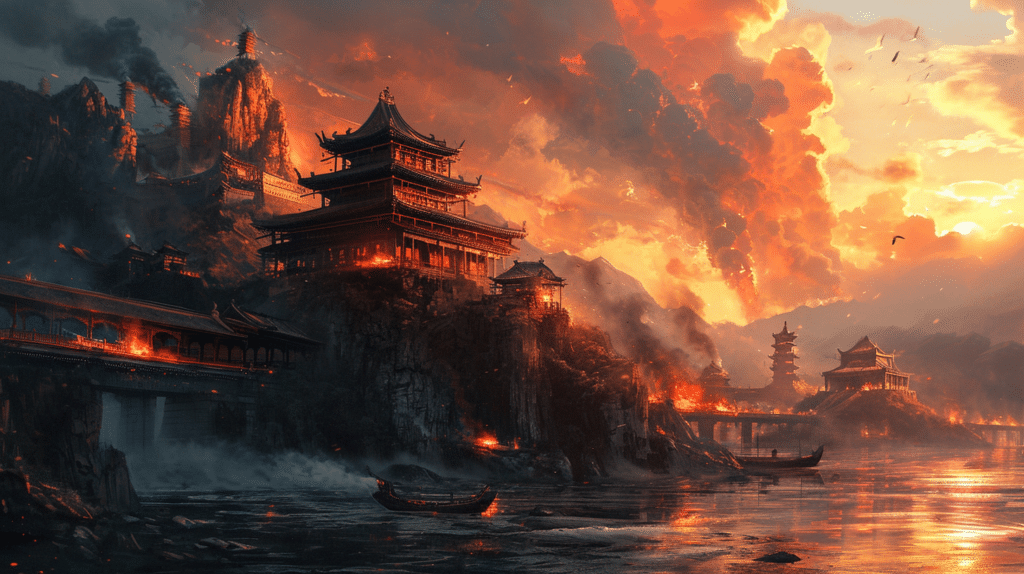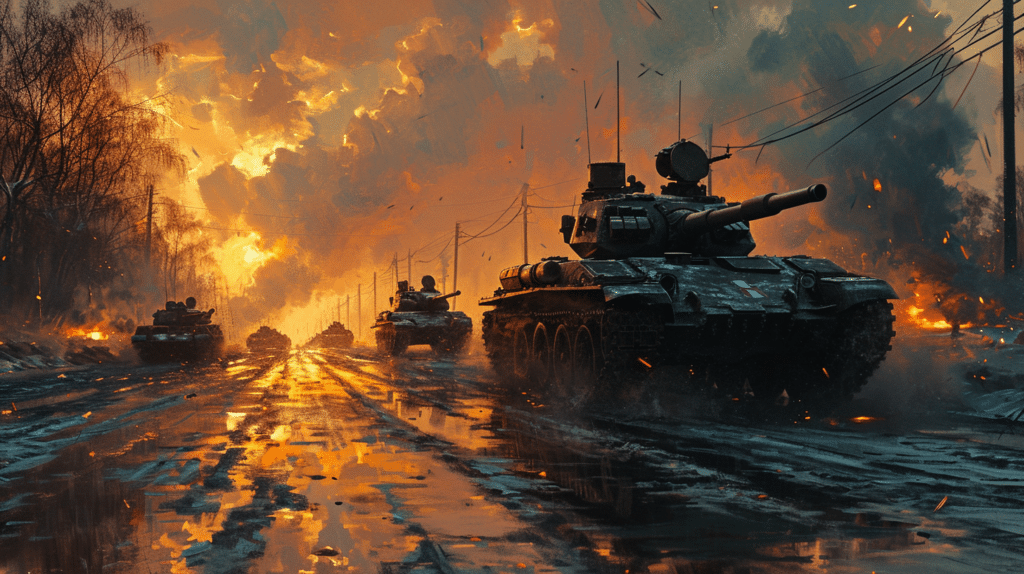
World War 3 - The Cataclysmic Conflict That Rattles Nations
By GZR News on January 4, 2024
As tensions between nations escalate, the world holds its breath, anticipating the outbreak of World War 3. The geopolitical landscape is fraught with rivalries and power struggles, creating a volatile environment where a single spark could ignite a catastrophic conflict. The stakes are high, with global superpowers vying for dominance and smaller nations caught in the crossfire. The world watches anxiously as the tension rises, knowing that the consequences of this conflict could be devastating.

The Trigger Event: Sparking the Conflict
The trigger event that ignited the flames of World War 3 was the Islamic empires’ restriction on Christian pilgrimage to the Holy Land. This restriction created a deep sense of resentment and tension between the Christian and Islamic worlds. The Crusades were a direct result of this conflict, as Christian nations sought to regain access to the sacred sites in Jerusalem. The Crusades marked the beginning of a long and bloody war that would shape the course of history.
The Major Players in World War 3
Superpowers Collide: USA vs China
The clash between the United States and China is a high-stakes battle for global dominance. Both superpowers are ramping up their military and diplomatic efforts in Asia, as they seek to outdo each other. The US, in a ‘once in a generation effort’, is boosting its military ties in the region to counter China’s growing influence. This escalating rivalry has the potential to reshape the geopolitical landscape and impact nations around the world. As tensions rise, the world watches with bated breath to see how this clash of titans unfolds.

The European Union’s Role in the Conflict
The European Union (EU) plays a crucial role in the cataclysmic conflict of World War 3. As a political and economic union comprising 27 member states, the EU wields significant influence on the global stage. In the face of escalating tensions, the EU has been actively engaged in diplomatic efforts to de-escalate the situation and promote peace. Through its collective security and defense policies, the EU aims to ensure the stability and security of its member states and the wider region.
The EU has also been instrumental in providing humanitarian aid and support to affected regions. It has mobilized resources and coordinated relief efforts to assist impacted communities. Additionally, the EU has implemented economic sanctions and trade restrictions to exert pressure on aggressor nations and deter further escalation of the conflict.
In the words of The Secret Teachings with Ryan Gable, ‘The European Union’s involvement in World War 3 highlights the importance of international cooperation and diplomacy in times of crisis.’ The EU’s role in this conflict underscores the complex dynamics and interconnectedness of global politics and the need for collaborative efforts to maintain peace and stability.
Russia’s Ambitions and Involvement
Russia plays a significant role in the cataclysmic conflict of World War 3. With its vast territory and military might, Russia has its own ambitions and interests in the outcome of the war. One of Russia’s main objectives is to expand its influence and regain its status as a global superpower. The country seeks to assert its dominance in Eastern Europe and Central Asia, aiming to establish a sphere of influence over neighboring countries. Additionally, Russia has been actively involved in supporting proxy forces and engaging in cyber warfare to destabilize its adversaries. The involvement of Russia in World War 3 adds another layer of complexity to the already volatile global situation.
The Battlefield: Global Hotspots
The Middle East: A Powder Keg
The Middle East has long been a region of intense geopolitical tensions and conflicts. With its rich history, diverse cultures, and strategic location, it has become a powder keg waiting to explode. The ongoing power struggles, religious rivalries, and territorial disputes have created a volatile environment that could easily ignite a global conflict. The presence of major world powers and their competing interests further complicates the situation, turning the region into a battleground for proxy wars. The Middle East is a ticking time bomb, and the consequences of its explosion would be catastrophic.
Asia-Pacific: A Region on the Brink
The Asia-Pacific region is a powder keg of geopolitical tensions and economic rivalries. With major powers like China, the United States, and Japan vying for influence, the stakes are high. Business leaders in the region are on the brink of a historic moment in the battle against inequality.
How they respond could have far-reaching consequences for the future. According to a report by PwC, the Net Zero Economy Index Asia Pacific Cut 2023, the region has the potential to lead the world in transitioning to a sustainable and inclusive economy. This is a critical opportunity for countries in the region to address pressing issues such as climate change, poverty, and social inequality.
By embracing sustainable practices and investing in green technologies, the Asia-Pacific region can not only mitigate the risks of conflict but also pave the way for a brighter and more prosperous future.

Europe: Caught in the Crossfire
As World War 3 unfolds, Europe finds itself in a precarious position, caught in the crossfire of global powers. With its strategic location and historical significance, Europe becomes a battleground for competing interests. The major players in the conflict, such as the United States, China, and Russia, vie for control and influence over European nations.
Support more articles like this.
Weapons of Mass Destruction: Unleashing Hell
Nuclear Armageddon: The Ultimate Threat
The threat of nuclear weapons is a grave concern in the context of World War 3. International bodies and proliferation experts warn that the danger of nuclear weapons use is higher than it’s been in decades. The destructive power of these weapons is unimaginable, capable of wiping out entire cities and causing long-lasting environmental damage. The potential for accidental or intentional use of nuclear weapons is a constant source of anxiety for the global community. Efforts to prevent nuclear proliferation and promote disarmament are crucial in order to avoid the catastrophic consequences of a nuclear Armageddon.

Biological Warfare: Silent and Deadly
Biological warfare is a terrifying form of warfare that utilizes deadly pathogens and toxins to cause widespread destruction and death. These weapons can be invisible and silent, making them difficult to detect and defend against. The use of biological weapons poses a significant threat to both military forces and civilian populations. The Biological Weapons Convention (BWC), also known as the Biological and Toxin Weapons Convention (BTWC), is a disarmament treaty that effectively bans biological and toxin weapons. It is an important international agreement aimed at preventing the use of these devastating weapons.
Peace with Biological Weapons
The BWC was first opened for signature in 1972 and has since been ratified by 183 countries. It prohibits the development, production, stockpiling, and acquisition of biological weapons. The treaty also requires member states to destroy any existing stockpiles of these weapons and to provide assistance to other states in the event of a biological weapons attack. The BWC has played a crucial role in reducing the threat of biological warfare and promoting global security and peace.
The Threat Remains
While the BWC has been successful in curbing the use of biological weapons, the threat still remains. Advances in biotechnology and genetic engineering have made it easier for rogue states and terrorist organizations to develop and deploy these weapons. The international community must remain vigilant and continue to strengthen measures to prevent the proliferation of biological weapons. Efforts to enhance surveillance, improve detection capabilities, and promote international cooperation are essential in countering this deadly threat.
In conclusion, biological warfare is a silent and deadly form of warfare that poses a significant threat to global security. The Biological Weapons Convention is an important international agreement that aims to prevent the use of these devastating weapons. While progress has been made in curbing the use of biological weapons, continued efforts are needed to address the evolving threat landscape and ensure a safer world for future generations.
Cyber Attacks: The New Battlefield
In the digital age, cyber attacks have become a new form of warfare. With the increasing reliance on technology, nations are vulnerable to cyber threats that can disrupt critical infrastructure, compromise personal information, and erode public trust. In 2023, India experienced a surge in these cyber attacks, leaving a trail of compromised personal information, disrupted operations, and eroded public trust. The Hindu Business Line reported that generative AI is expected to be the new battlefield for cyber space in 2024. This technology has the potential to revolutionize cyber attacks, making them more sophisticated and difficult to detect. As nations continue to invest in cybersecurity measures, it is crucial to stay informed and educated about the evolving threats in cyberspace.
The Human Cost: Lives Lost and Nations Destroyed
Millions Dead: The Toll of World War 3
World War 3 has left a devastating trail of destruction, with millions of lives lost in its wake. The scale of the conflict is unprecedented, surpassing even the deadliest wars in history. Entire cities have been reduced to rubble, and once-thriving communities now lie in ruins. The human cost of this cataclysmic conflict is immeasurable, leaving behind a legacy of pain and suffering that will be felt for generations to come.
The toll of World War 3 extends far beyond the loss of life. The economic impact has been catastrophic, with global markets in turmoil and nations on the brink of collapse. Infrastructure has been decimated, hindering efforts to rebuild and recover. The refugee crisis has reached unprecedented levels, with millions displaced from their homes and seeking refuge in overcrowded camps. The social fabric of societies has been torn apart, as communities struggle to cope with the aftermath of war.
In the face of such devastation, it is crucial that the international community comes together to support those affected by World War 3. Humanitarian aid and assistance must be provided to those in need, helping to alleviate suffering and rebuild shattered lives. Diplomatic efforts must also be intensified, with a focus on finding peaceful resolutions and preventing future conflicts. Only through collective action and cooperation can we hope to bring about a world where the horrors of World War 3 are never repeated.

Refugee Crisis: Displaced and Desperate
The refugee crisis resulting from World War 3 has led to unprecedented displacement and desperation. Millions of people have been forced to flee their homes, seeking safety and refuge in neighboring countries or even continents away. The scale of this crisis is immense, with Syria alone representing nearly 25% of the total global refugee population.
As of mid-2023, 6.49 million Syrians have been displaced, highlighting the magnitude of the humanitarian challenge. The impact of this crisis goes beyond the immediate displacement, as it puts immense strain on host countries and creates social, economic, and political challenges.
International aid organizations and governments are working tirelessly to provide assistance and support to those affected, but the road to recovery will be long and arduous.
Economic Collapse: The Aftermath of Destruction
The economic collapse that follows the destruction of World War 3 is nothing short of catastrophic. Nations that once thrived now find themselves in ruins, their economies in shambles. The loss of infrastructure, resources, and skilled labor leaves countries struggling to rebuild. Hyperinflation runs rampant, causing prices to skyrocket and rendering currencies worthless. The global financial system is in disarray, with banks failing and markets crashing. It’s a bleak and desperate time for the survivors.
In the aftermath of the economic collapse, nations face a myriad of challenges. Unemployment soars as businesses shut down and industries collapse. The lack of jobs leads to widespread poverty and social unrest. Governments struggle to provide basic services and support to their citizens. Food shortages become a harsh reality, as agricultural production is disrupted and supply chains are broken. People are forced to ration and scavenge for survival.
The economic collapse also has far-reaching geopolitical consequences. Power shifts occur as once dominant nations lose their economic influence, while emerging powers rise to fill the void. Alliances are formed and broken as countries scramble to secure resources and rebuild their economies. The global balance of power is forever altered.
Rebuilding after the economic collapse is a monumental task. It requires not only physical reconstruction but also the healing of societies and the restoration of trust. International cooperation and assistance play a crucial role in this process. Investment in infrastructure, education, and healthcare is essential to create a foundation for sustainable growth. It’s a long and arduous journey, but with determination and resilience, nations can rise from the ashes and build a better future.
The Endgame: Seeking Peace in the Chaos
Diplomatic Efforts: Can Talks Prevent Disaster?
In the midst of the chaos and destruction of World War 3, diplomatic efforts emerge as a glimmer of hope. As nations reel from the devastating consequences of the conflict, leaders from around the world gather to engage in high-stakes negotiations. The goal: to find a peaceful resolution and prevent further catastrophe.
These diplomatic talks are not without challenges. Deep-rooted animosities, conflicting interests, and power struggles threaten to derail any progress. However, the alternative is unthinkable. The world cannot afford to let the flames of war continue to consume nations and lives.
To facilitate these discussions, international organizations such as the United Nations play a crucial role. They provide a neutral platform for dialogue and mediation, bringing together representatives from all sides. Through diplomatic channels, they work tirelessly to bridge the gaps and find common ground.
But can talks alone prevent disaster? The answer is complex. While diplomacy offers a path to peace, it requires genuine commitment and willingness to compromise. It demands leaders who prioritize the well-being of their people over personal agendas. It necessitates a recognition of shared humanity and the understanding that war is not the solution.
In the face of such immense challenges, the world looks to these diplomatic efforts with a mix of hope and skepticism. The stakes are high, and the consequences of failure are dire. But if successful, these talks have the potential to save lives, rebuild nations, and create a future free from the horrors of World War 3.

The Role of International Organizations
International organizations play a crucial role in mitigating the effects of World War 3 and working towards peace. One such organization is Ground Zero with Clyde Lewis, which provides a platform for open discussions and analysis of the conflict. Through their insightful discussions and expert opinions, Ground Zero helps shed light on the complexities of the war and its impact on nations. They also facilitate diplomatic efforts by bringing together representatives from different countries to find common ground and seek peaceful resolutions. Their efforts are instrumental in rebuilding nations and fostering hope in the midst of chaos.
Rebuilding Nations: From Ashes to Hope
After the devastation of World War 3, the task of rebuilding nations falls on the shoulders of governments, aid organizations, and the resilient spirit of the affected communities. The road to recovery is long and arduous, but it is not without hope. African governments and various aid organizations have mobilized resources to assist the impacted communities, providing immediate relief efforts and essential aid. The focus is not only on addressing the immediate needs but also on the long-term rebuilding process. South Africans have shared diverse views on the situation, with attributions ranging from divine retribution to poor governance. Amidst the challenges, there is a glimmer of hope as communities come together to rebuild and restore what was lost.
In the midst of chaos and uncertainty, finding peace can seem like an impossible task. However, at Aftermath Media, we specialize in uncovering the truth behind parapolitics, UFOs, and conspiracies. Our mission is to provide you with the ultimate resource for understanding the enigmatic events that shape our world. Visit our website to explore the latest insights, join the conversation, and discover a community dedicated to seeking truth in the aftermath.
In Conclusion
World War 3 – The Cataclysmic Conflict That Rattles Nations has explored the potential causes, consequences, and impacts of a hypothetical global conflict. From the devastating effects on human lives and infrastructure to the economic and social upheaval, the article has shed light on the catastrophic nature of such a war. It is crucial for nations to prioritize diplomacy, peace-building, and international cooperation to prevent the outbreak of such a conflict. The world must learn from history and work towards a future of peace and stability.
Frequently Asked Questions
What were the main causes of World War 3?
The main causes of World War 3 were escalating tensions between superpowers, a trigger event that sparked the conflict, and the ambitions and involvement of major players like the USA, China, Russia, and the European Union.
Which regions were the major battlegrounds in World War 3?
The major battlegrounds in World War 3 were the Middle East, Asia-Pacific, and Europe.
What were the weapons of mass destruction used in World War 3?
The weapons of mass destruction used in World War 3 included nuclear weapons, biological warfare, and cyber attacks.
How many lives were lost in World War 3?
Millions of lives were lost in World War 3, resulting in a devastating human cost.
What were the consequences of World War 3?
The consequences of World War 3 included a refugee crisis, economic collapse, and the destruction of nations.
Were there any efforts to seek peace during World War 3?
Yes, there were diplomatic efforts and the involvement of international organizations in seeking peace during World War 3. Additionally, rebuilding nations was a crucial part of the post-war process.